French style has long been synonymous with sophistication, and nowhere is this more evident than in men’s grooming.
When it comes to hairstyles, French men have mastered the art of looking effortlessly refined while maintaining an air of casual elegance that seems almost natural.
The beauty of French hairstyles lies in their versatility—they work equally well in a Parisian café, a corporate boardroom, or a weekend gathering with friends.
This comprehensive guide to 30 Classic French Hairstyles for Men That Never Go Out of Style explores the timeless cuts and styling techniques that have made French grooming iconic worldwide.
From the textured crop that dominated the streets of Paris to the slicked-back undercut favored by French cinema legends, each style offers a unique approach to masculine elegance.
Whether you have thick, wavy hair or fine, straight locks, you’ll discover how to achieve that coveted French aesthetic that balances structure with nonchalance.
These hairstyles transcend seasonal trends and continue to inspire men across generations, proving that true style is indeed timeless.
Prepare to transform your look with these enduring French classics that combine practicality with undeniable charm.
Contents
- 1 1. The French Crop
- 2 2. Slicked Back Undercut
- 3 3. Textured Quiff
- 4 4. Side Part Classic
- 5 5. Messy Fringe
- 6 6. Pompadour Fade
- 7 7. Tousled Medium Length
- 8 8. Buzz Cut with Texture
- 9 9. Wavy Brushed Back
- 10 10. Short Spiky Cut
- 11 11. Long Swept Bangs
- 12 12. Ivy League Cut
- 13 13. Curly Top with Fade
- 14 14. Slicked Side Part
- 15 15. Textured Caesar Cut
- 16 16. Medium Length Side Swept
- 17 17. Disconnected Undercut
- 18 18. Natural Flow
- 19 19. Forward Brushed Crop
- 20 20. Angular Fringe
- 21 21. Vintage Pompadour
- 22 22. Short Textured Layers
- 23 23. Shaggy Mid-Length
- 24 24. Clean Taper
- 25 25. Loose Waves
- 26 26. Military Inspired Crew Cut
- 27 27. Side Fade with Volume
- 28 28. Refined Combover
- 29 29. Artistic Asymmetry
- 30 30. Classic Gentleman’s Cut
- 31 Essential Styling Products for French Hairstyles
- 32 Hair Care Tips for Maintaining French Style
- 33 Choosing the Right French Style for Your Face Shape
- 34 The Cultural Significance of French Male Grooming
- 35 Common Mistakes to Avoid
- 36 Adapting French Styles for Different Settings
- 37 Seasonal Considerations for French Hairstyles
- 38 Conclusion
1. The French Crop

The French Crop represents the foundation of modern French hairstyling, characterized by its short length on the sides and slightly longer texture on top.
This versatile cut has been a staple in French barbershops for decades, offering a clean yet relaxed appearance that suits various face shapes and hair types.
- The French Crop features hair that is cut short around the sides and back, typically using clippers with a guard between 2 and 4.
- The top section maintains length ranging from one to three inches, allowing for texture and movement.
- A defining characteristic is the short fringe that sits just above the eyebrows, creating a horizontal line across the forehead.
- This style works exceptionally well for men with receding hairlines as the fringe draws attention forward.
- Styling requires minimal product—a small amount of matte clay or paste worked through damp hair creates the signature textured finish.
- The cut grows out gracefully, requiring maintenance every 4-6 weeks to preserve the shape.
- French Crops can be customized with fade variations on the sides or disconnected undercuts for added dimension.
2. Slicked Back Undercut
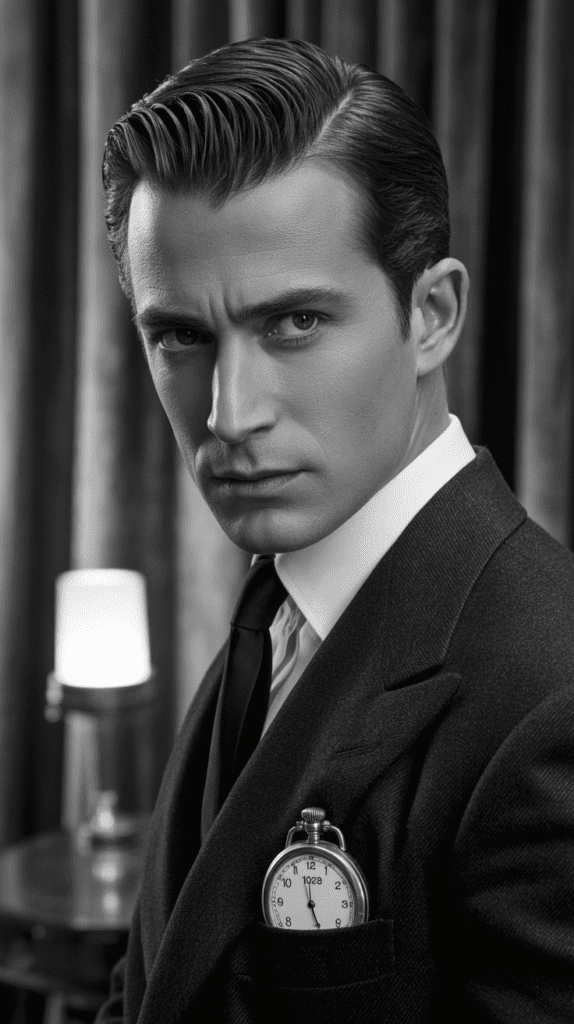
The Slicked Back Undercut embodies Parisian sophistication with its dramatic contrast between closely shaved sides and longer top hair swept backward.
This style became iconic through French cinema and remains a powerful choice for men seeking a bold, refined look.
- The undercut involves shaving or closely trimming the sides and back to create a stark contrast with the longer top.
- Top hair should be at least 4-6 inches long to achieve the proper slicked-back effect.
- High-shine pomade or gel is essential for creating the glossy, wet-look finish characteristic of this style.
- Hair is combed straight back from the forehead, with all strands moving in the same direction for uniformity.
- This style pairs exceptionally well with beards, creating a balanced masculine aesthetic.
- The slicked-back undercut requires daily styling and works best on straight to slightly wavy hair textures.
- Evening touch-ups may be necessary as the style can lose its shape throughout the day.
3. Textured Quiff
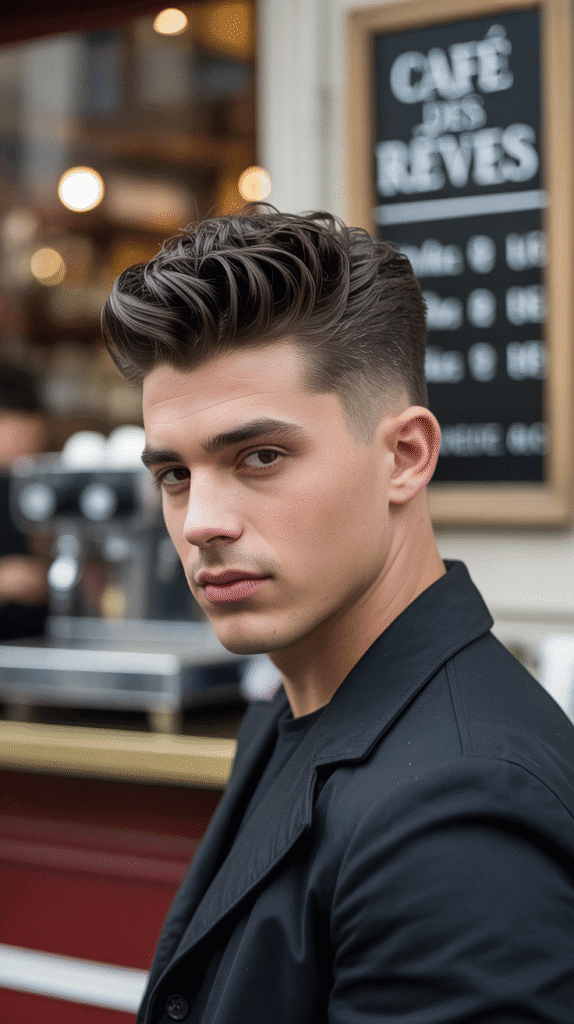
The Textured Quiff takes the classic pompadour concept and infuses it with French casual elegance, creating volume at the front while maintaining a lived-in, touchable texture.
This style strikes the perfect balance between formal structure and relaxed sophistication.
- The quiff creates height and volume by lifting hair upward and slightly backward from the forehead.
- Unlike heavily styled pompadours, the French textured quiff maintains a more natural, piece-y appearance.
- Sides are typically kept shorter, though not as dramatic as an undercut, allowing for gradual blending.
- Pre-styling with sea salt spray on damp hair builds the foundation for lasting volume.
- A blow dryer is directed upward while combing to establish the quiff’s height and shape.
- Matte finish products like clay or fiber paste preserve texture while providing hold without excessive shine.
- This style works beautifully on medium-length hair with natural wave or curl patterns.
4. Side Part Classic

The Side Part Classic remains one of the most timeless French hairstyles, offering clean lines and traditional elegance that has graced French businessmen and artists alike for generations.
This sophisticated cut proves that simplicity can be extraordinarily stylish.
- A precise side part is created using a comb, typically positioned above the outer corner of one eye.
- Hair on the heavier side of the part is combed across and slightly back, while the other side lies flat against the head.
- This style requires hair length of approximately 2-4 inches on top for proper execution.
- Medium-hold pomade with moderate shine creates the polished finish associated with this classic look.
- The side part works exceptionally well for formal occasions and professional environments.
- Regular trims every 3-4 weeks maintain the clean lines essential to this style’s refined appearance.
- This cut suits all face shapes and can be adapted for various hair textures.
5. Messy Fringe
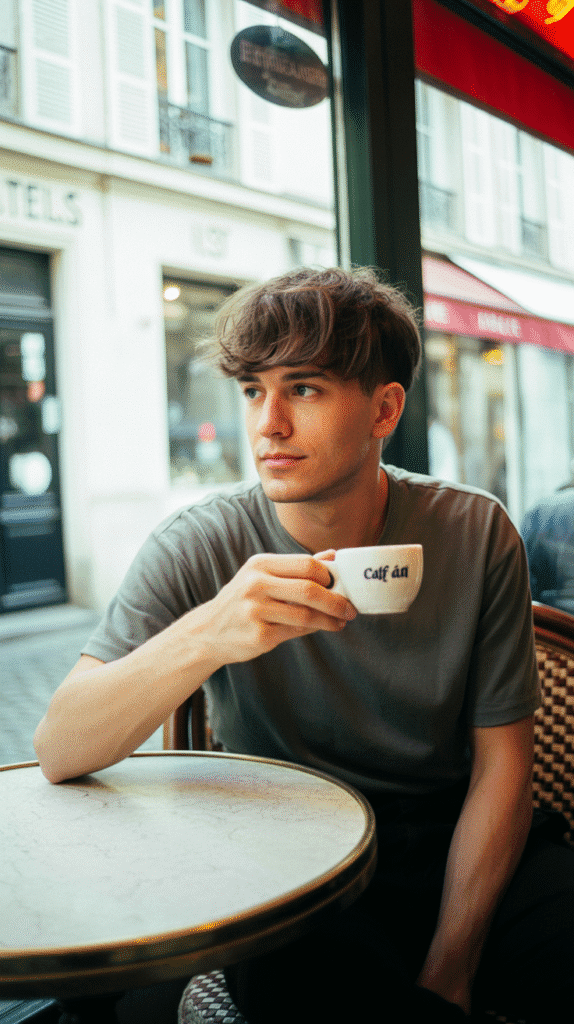
The Messy Fringe captures the essence of French nonchalance, featuring deliberately tousled bangs that fall naturally across the forehead.
This youthful style has dominated French fashion districts and art scenes, representing carefree confidence.
- The fringe section is cut to fall somewhere between the eyebrows and the bridge of the nose.
- Layers throughout the top and fringe create movement and prevent the style from appearing heavy or blunt.
- Sides and back are kept shorter to emphasize the textured fringe as the focal point.
- Styling involves working a small amount of texturizing product through towel-dried hair with fingers.
- The “messy” appearance should look intentional rather than unkempt, requiring strategic placement of pieces.
- This style benefits from air drying or minimal blow-drying to preserve natural texture.
- The messy fringe works particularly well for men with straight to wavy hair and oval or heart-shaped faces.
6. Pompadour Fade
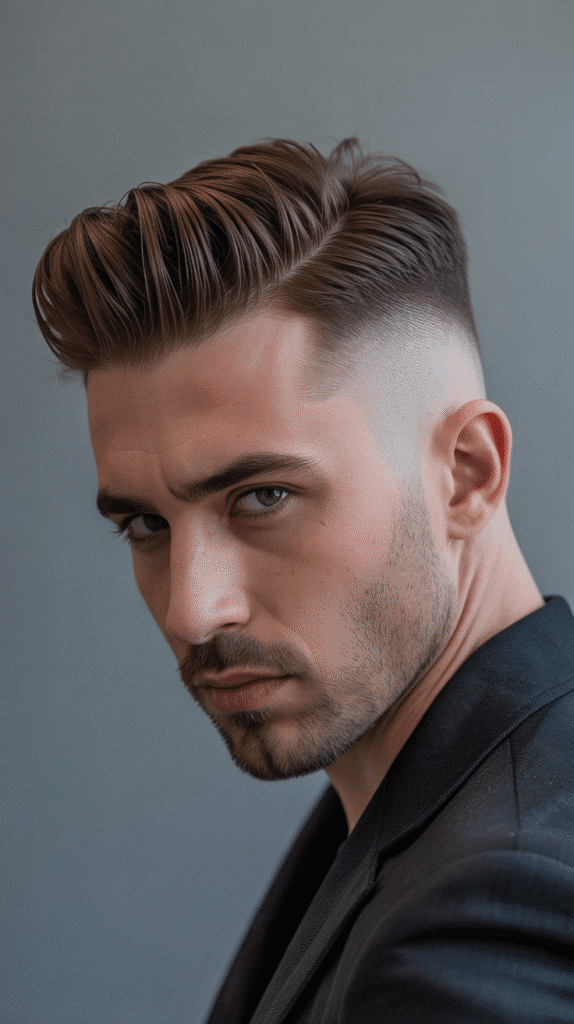
The Pompadour Fade combines the dramatic height of the classic pompadour with modern fade techniques, creating a contemporary French interpretation of vintage American style.
This hybrid approach has become increasingly popular in urban French barbershops.
- The pompadour section rises dramatically from the forehead, creating impressive vertical height.
- A fade transitions gradually from longer hair on top to skin or very short hair at the neckline and around the ears.
- This style requires significant length on top—typically 4-6 inches minimum for proper pompadour structure.
- Strong-hold pomade or styling cream is necessary to maintain the pompadour’s height throughout the day.
- Blow-drying while lifting hair upward and backward establishes the foundational shape before product application.
- The fade portion requires skilled barbering and regular maintenance every 2-3 weeks to preserve crispness.
- This bold style makes a statement and suits men with oval, square, or diamond-shaped faces.
7. Tousled Medium Length
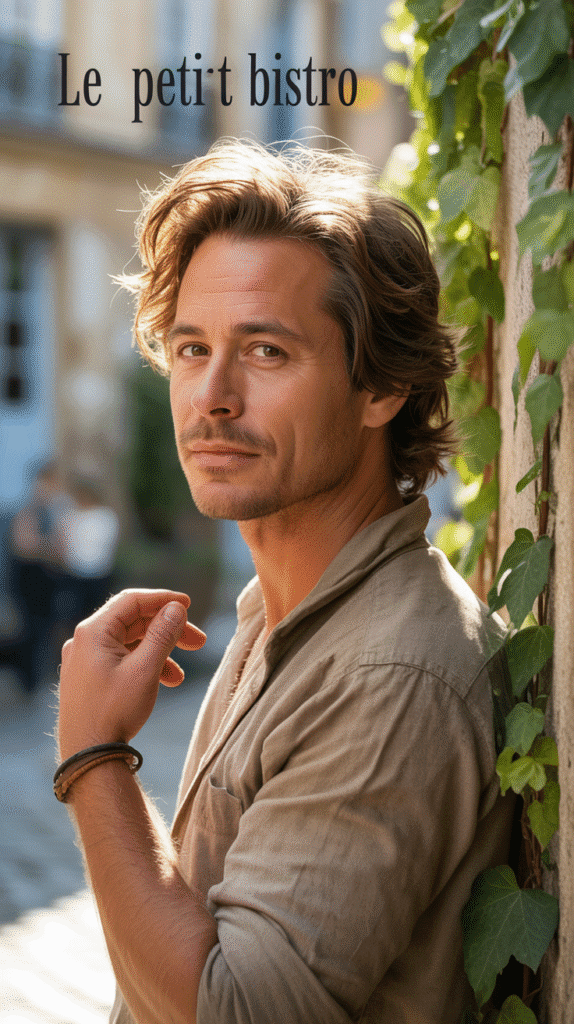
The Tousled Medium Length style epitomizes French effortlessness, featuring hair that falls between the ears and shoulders with deliberately casual styling.
This romantic look has been favored by French artists and intellectuals throughout history.
- Hair length extends to approximately ear level or slightly below, with layers throughout to prevent excess weight.
- The tousled effect is achieved through combination of natural air drying and minimal product application.
- This style works best on naturally wavy or slightly curly hair textures that hold shape without heavy styling.
- A light texturizing spray or small amount of sea salt spray enhances natural wave patterns.
- Regular trims every 6-8 weeks remove split ends while maintaining the overall length and shape.
- The middle part or subtle side part complements the casual, artistic aesthetic of this style.
- This cut requires confidence to wear as the longer length makes a distinctive personal statement.
8. Buzz Cut with Texture
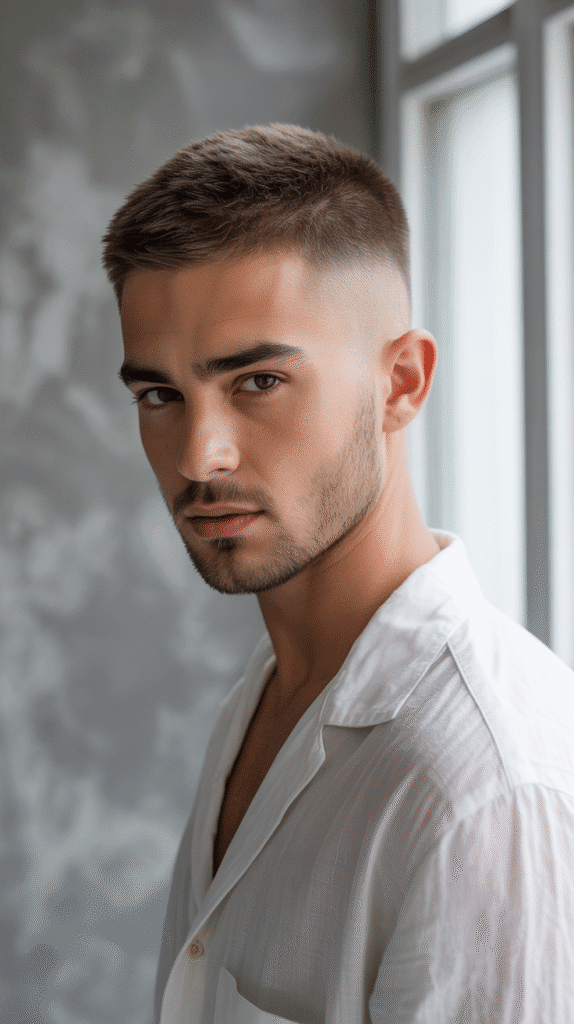
The Buzz Cut with Texture offers a French twist on military-inspired simplicity, maintaining ultra-short length while preserving enough hair to create subtle texture and dimension.
This low-maintenance style has gained popularity among modern French men seeking practicality without sacrificing style.
- Hair is clipped to a uniform length between 3-12 millimeters using clippers, depending on personal preference.
- Unlike completely shaved heads, this cut maintains enough length to show natural hair texture and growth patterns.
- The texture variation comes from natural hair direction and density rather than deliberate styling.
- Minimal to no product is required, though a light matte paste can define texture for special occasions.
- This style suits men with well-shaped heads and strong facial features that aren’t overshadowed by minimal hair.
- Maintenance involves self-trimming or barbershop visits every 2-3 weeks to preserve the desired length.
- The buzz cut works in all professional and casual settings, offering unmatched versatility.
9. Wavy Brushed Back
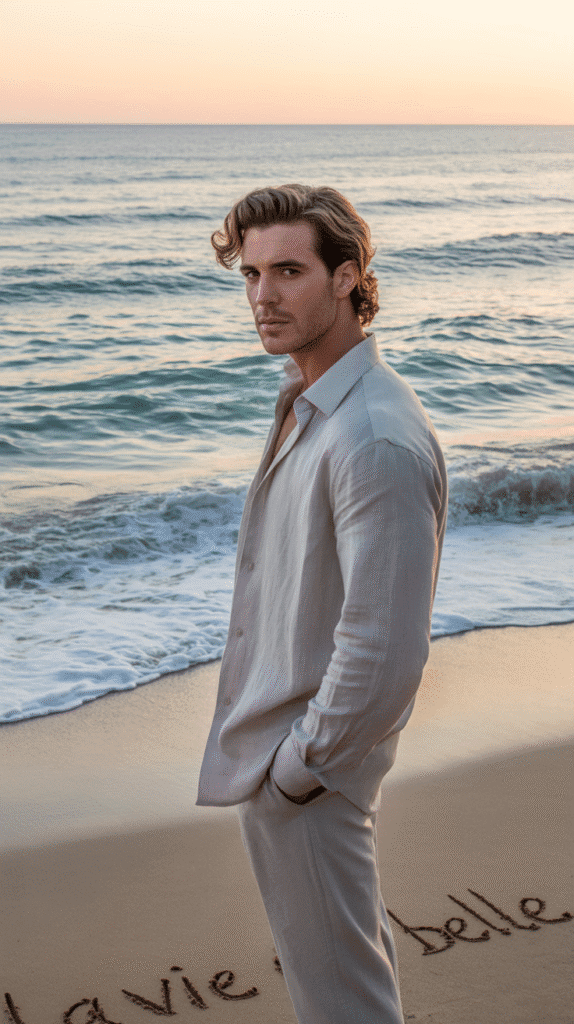
The Wavy Brushed Back style celebrates natural texture by sweeping wavy hair backward from the face, creating a sophisticated yet relaxed appearance.
This effortless look has been a cornerstone of French Riviera style for decades.
- This style requires medium to long length hair with natural wave or curl pattern.
- Hair is brushed or combed backward from the hairline, following the natural direction of wave formation.
- A light to medium hold cream or oil-based product provides control while maintaining hair’s natural movement.
- The sides can be left longer to blend with the top or trimmed shorter for more structured definition.
- This cut works beautifully when slightly damp or after swimming, embracing the natural texture.
- Regular deep conditioning treatments keep waves defined and prevent frizz that can disrupt the smooth backward flow.
- The wavy brushed back style suits men with naturally textured hair and complements relaxed, sophisticated wardrobes.
10. Short Spiky Cut
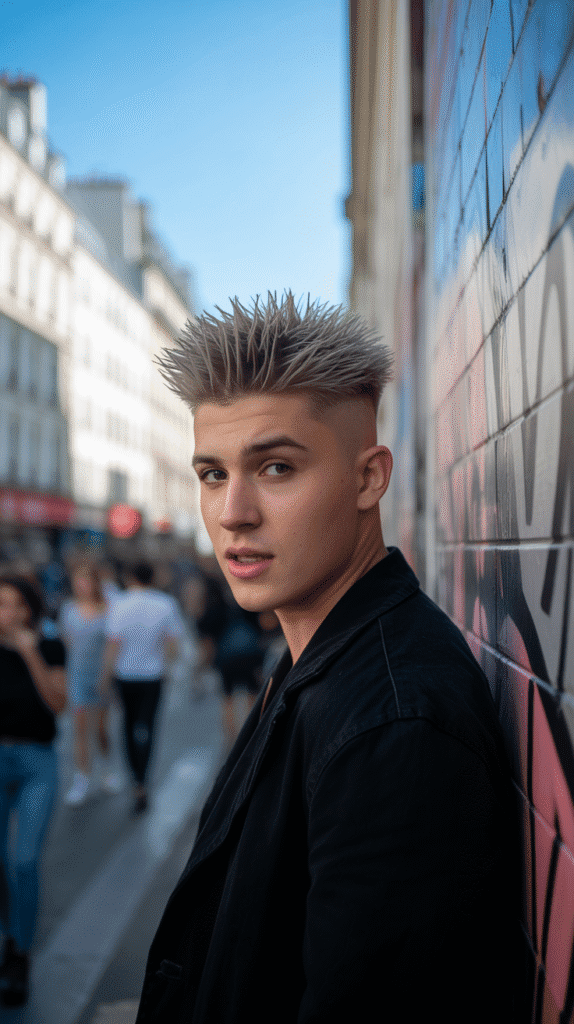
The Short Spiky Cut brings playful energy to French hairstyling while maintaining the clean, intentional aesthetic characteristic of French grooming.
This youthful style features hair standing upright in controlled spikes across the top of the head.
- Hair on top is cut to approximately 1-2 inches, providing sufficient length to create upward spikes.
- Sides and back are trimmed significantly shorter, often with a fade or taper to emphasize the spiky top section.
- Strong-hold gel, wax, or fiber paste is worked through damp hair, then directed upward with fingers.
- Spikes can be uniform in height and direction or varied for a more organic, textured appearance.
- This style holds up well throughout the day due to the short length and strong product application.
- The spiky cut works best on straight or slightly wavy hair with sufficient thickness to support upright styling.
- Regular maintenance every 3-4 weeks prevents the style from growing out and losing its defined shape.
11. Long Swept Bangs
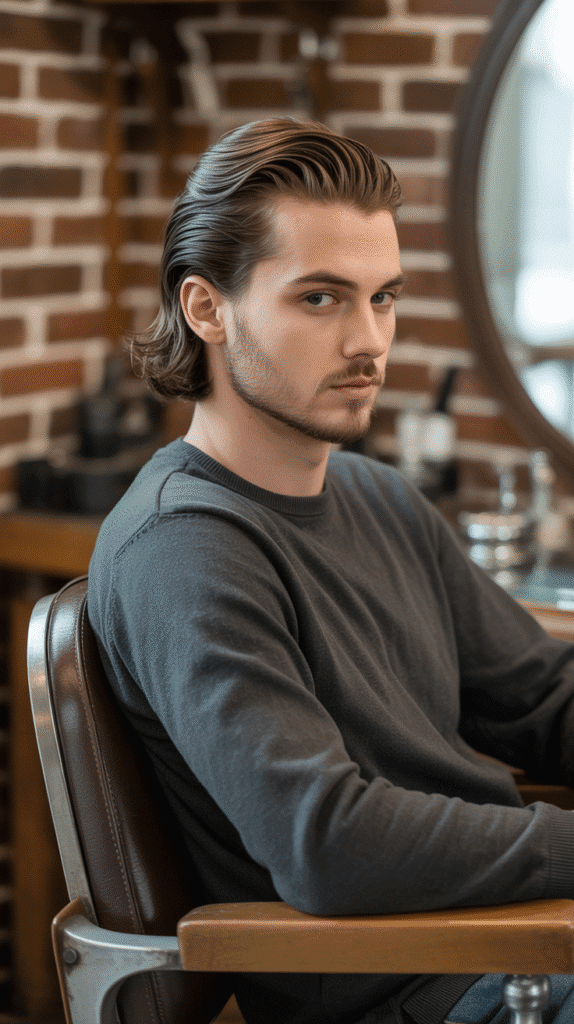
The Long Swept Bangs style features extended fringe that dramatically sweeps to one side, creating an artistic, asymmetrical look favored by French creatives and fashion-forward individuals.
This distinctive cut makes a bold statement while remaining surprisingly wearable.
- The bang section is cut to extend past the eyebrows, often reaching cheekbone length or beyond.
- Hair is directed to sweep dramatically across the forehead toward one side of the face.
- Layers throughout the bangs prevent excessive weight and allow for natural movement and flow.
- The back and sides can vary in length but typically remain shorter to emphasize the dramatic fringe.
- Lightweight styling cream or mousse provides hold without weighing down the swept portion.
- This style requires frequent adjusting throughout the day as the long bangs naturally fall forward.
- Long swept bangs work best on straight to wavy hair and suit oval, heart, or diamond-shaped faces.
12. Ivy League Cut
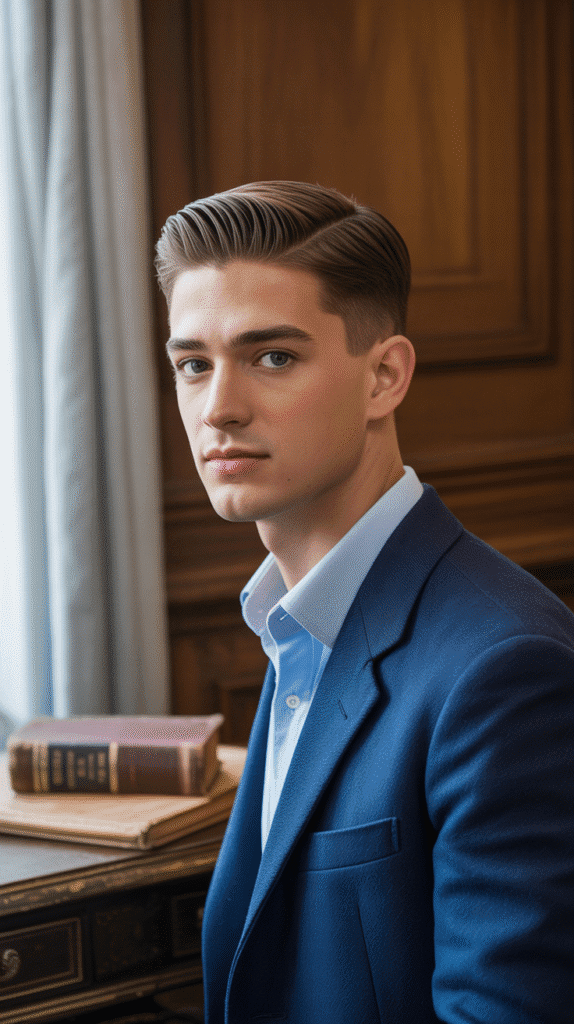
The Ivy League Cut represents collegiate elegance with French refinement, featuring slightly longer length on top than a crew cut while maintaining the same clean, tapered sides.
This preppy style has found a permanent place in French men’s grooming repertoires.
- Top hair is cut to approximately 1-2 inches, long enough to create a subtle side part or brush to the side.
- Sides and back feature a gradual taper that blends smoothly from longer top hair to shorter lengths at the edges.
- The front section can be styled forward, to the side, or with a slight lift for added dimension.
- Light to medium-hold pomade or styling cream provides structure while maintaining a natural appearance.
- This versatile cut transitions seamlessly from casual to formal settings with minimal styling adjustment.
- The Ivy League works exceptionally well for professional environments while remaining youthful and approachable.
- Maintenance every 4-5 weeks keeps the proportions balanced and the taper clean.
13. Curly Top with Fade
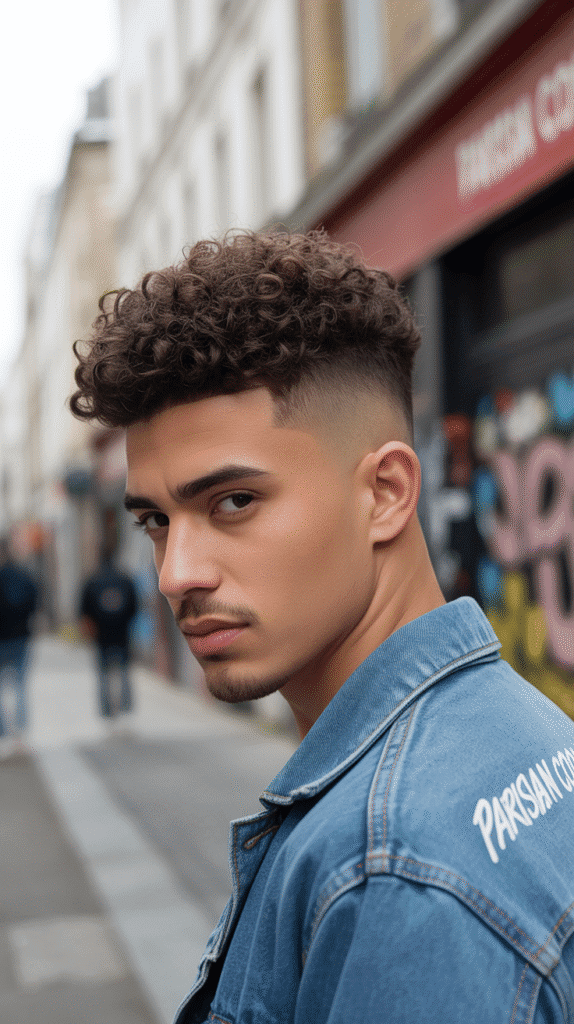
The Curly Top with Fade celebrates natural curl texture by allowing curls to flourish on top while maintaining clean, faded sides.
This modern French style embraces natural hair patterns rather than fighting against them.
- Natural curls are allowed to grow to 3-5 inches on top, creating volume and distinctive texture.
- A fade begins at the temples and progresses downward, creating clean contrast with the curly top section.
- Curl-defining cream or gel is applied to damp hair, then allowed to air dry or diffused for enhanced definition.
- The key is maintaining curl health through proper moisture and avoiding products that cause crunchiness or stiffness.
- This style works exclusively for men with naturally curly or coily hair textures.
- The fade requires regular maintenance every 2-3 weeks, while the curly top can grow longer between trims.
- Curly tops pair exceptionally well with beards, creating a balanced, masculine aesthetic.
14. Slicked Side Part
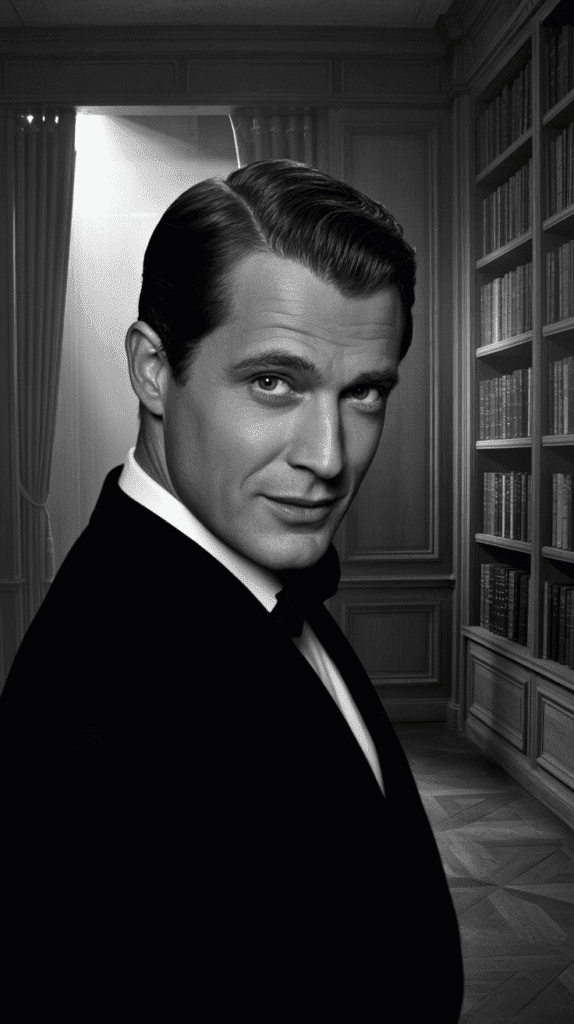
The Slicked Side Part elevates the classic side part with high-shine product and precise execution, creating a formal, elegant look reminiscent of 1920s French sophistication.
This refined style remains popular for special occasions and formal settings.
- A sharp, clean part is created using a fine-tooth comb, positioned consistently in the same location for each styling.
- High-shine pomade is distributed evenly throughout the hair, then combed flat against the head on both sides of the part.
- The heavier side sweeps across and slightly back, while the lighter side lies completely flat.
- This style requires medium to long length hair—approximately 3-5 inches on top for proper execution.
- Hair must remain perfectly smooth without flyaways or textured pieces disrupting the sleek surface.
- The slicked side part suits formal events, black-tie occasions, and vintage-inspired aesthetic preferences.
- Touch-ups throughout the day may be necessary to maintain the pristine, glossy appearance.
15. Textured Caesar Cut
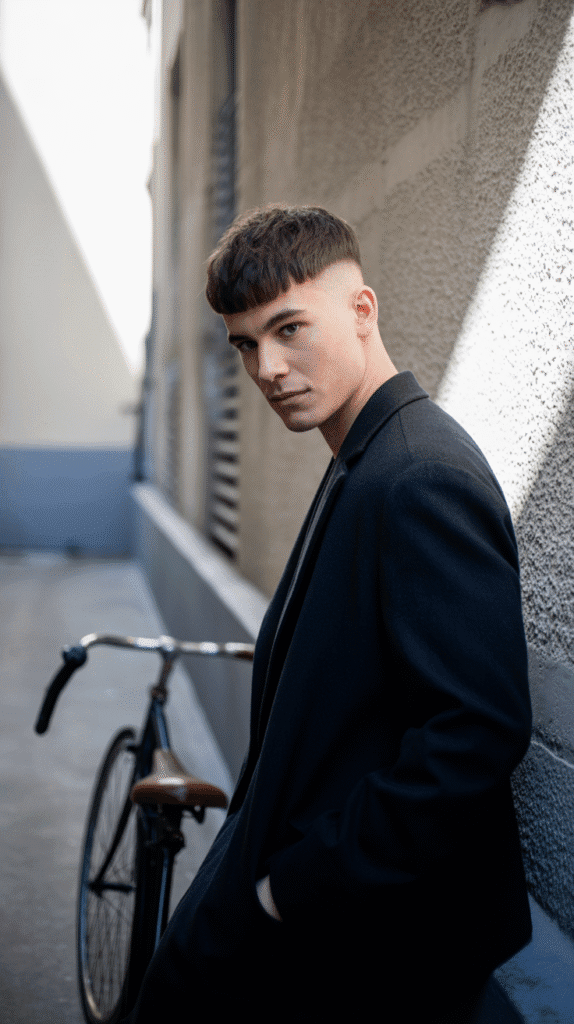
The Textured Caesar Cut modernizes the Roman-inspired classic with added dimension and piece-y texture, creating a contemporary French interpretation of this historically significant style.
The horizontally cut fringe remains the defining characteristic.
- The Caesar features a short, horizontally cut fringe that sits close to the forehead, typically 1-2 inches in length.
- Top hair maintains similar length throughout, creating a uniform appearance from front to back.
- Modern texture is added through point-cutting techniques and strategic product application with fingers.
- Sides and back are trimmed short but not as dramatically as disconnected undercuts, allowing for gradual blending.
- Matte paste or clay worked through slightly damp hair creates the textured, lived-in finish.
- This cut works particularly well for men with thinning hair as the forward styling creates fullness.
- The Caesar requires minimal daily styling, making it ideal for low-maintenance routines.
16. Medium Length Side Swept

The Medium Length Side Swept style allows hair to grow to a moderate length while maintaining direction and control through strategic side-swept styling.
This versatile French look works equally well in creative and professional environments.
- Hair length extends to approximately 3-5 inches on top, with sides either matching or trimmed shorter.
- All hair is directed to sweep toward one side of the head, creating diagonal lines across the scalp.
- A deep side part enhances the swept effect, though some versions work without a defined part.
- Medium-hold cream or light pomade provides control while allowing natural movement and flow.
- This style benefits from blow-drying in the desired direction to establish shape before product application.
- The medium length side swept works for various hair textures, though straight to wavy hair shows the sweep most clearly.
- Regular trims every 5-6 weeks maintain the length and remove weight that could cause the style to fall flat.
17. Disconnected Undercut
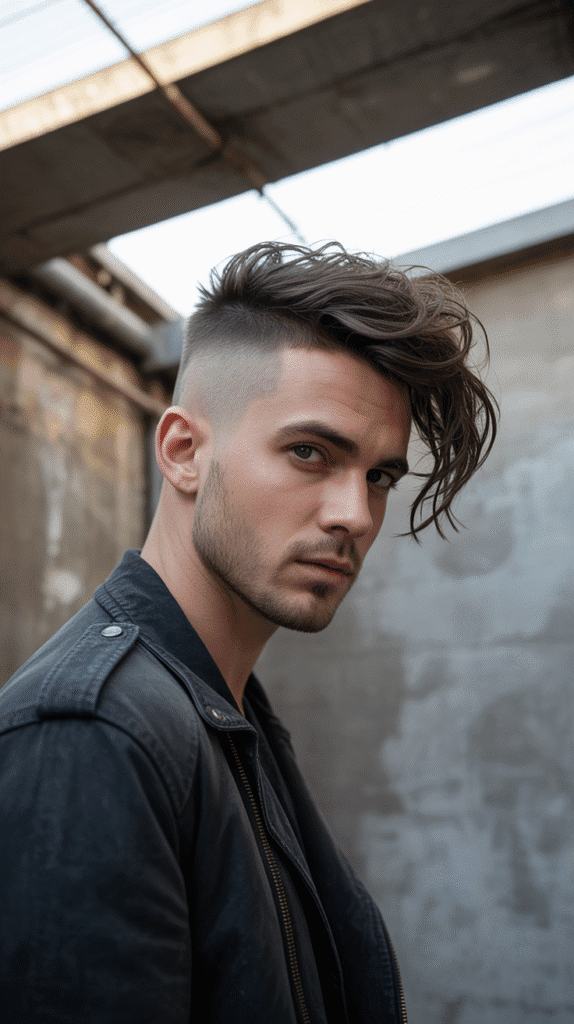
The Disconnected Undercut creates dramatic contrast through an abrupt transition between very short sides and significantly longer top hair with no gradual blending.
This bold French style has become a staple in fashion-forward barbershops.
- Sides and back are shaved or clipped to minimal length, often using no guard or a #1 guard.
- Top hair is left substantially longer—typically 4-6 inches or more—creating a stark dividing line.
- The “disconnection” refers to the lack of fade or blend between the long and short sections.
- Top hair can be styled in numerous ways: slicked back, swept to the side, textured, or formed into a quiff.
- This style requires confidence and commitment as the dramatic contrast makes a strong visual statement.
- Maintenance demands regular side and back shaving every 1-2 weeks to preserve the clean undercut.
- The disconnected undercut suits men with thick hair on top and strong facial features to balance the bold cut.
18. Natural Flow
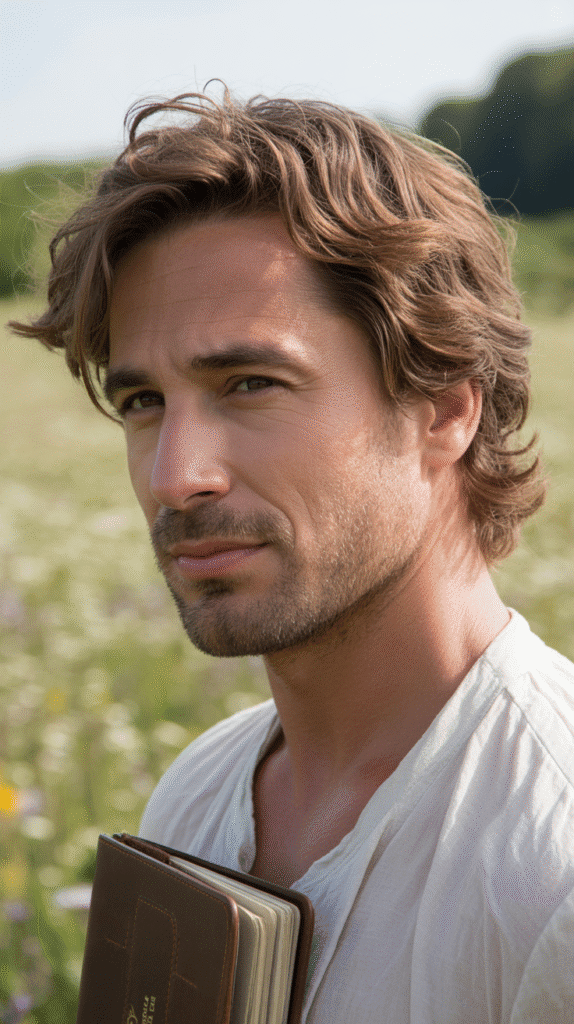
The Natural Flow style embraces hair’s inherent movement and texture with minimal intervention, allowing locks to fall naturally while maintaining a well-groomed appearance.
This effortless French approach celebrates individual hair characteristics.
- Hair is cut with subtle layers that enhance natural movement patterns rather than imposing artificial structure.
- Length varies based on personal preference but typically ranges from medium to long.
- Minimal product is used—often just a small amount of leave-in conditioner or light oil for sheen and manageability.
- Hair is allowed to air dry, following its natural growth patterns and texture without forced direction.
- Regular trims every 6-8 weeks maintain hair health and shape without drastically altering the length.
- This style works beautifully for men with naturally wavy or slightly curly hair that forms appealing patterns.
- The natural flow represents the ultimate expression of French “je ne sais quoi” in hairstyling—looking great without appearing to try.
19. Forward Brushed Crop
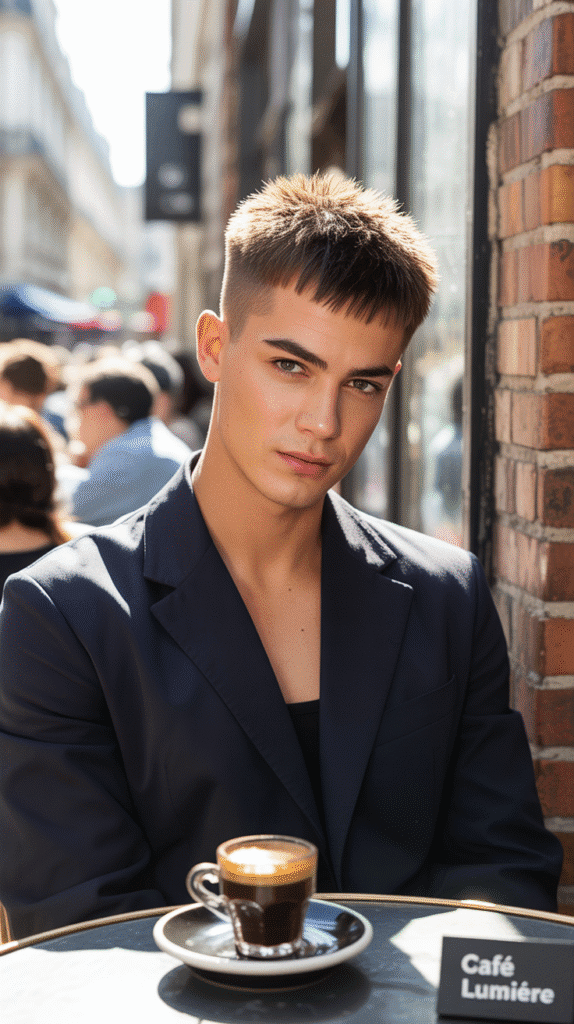
The Forward Brushed Crop directs hair toward the face with intentional forward movement, creating a youthful, energetic appearance.
This French style variation adds dimension to the classic crop through directional styling.
- Hair on top is cut to 2-4 inches, providing sufficient length for forward direction while maintaining manageability.
- All hair is styled to move toward the face, with the fringe potentially covering part of the forehead.
- Sides remain shorter, either faded or trimmed close to create contrast with the longer top.
- Texturizing product is worked through damp hair, then brushed or combed forward with fingers.
- This style softens angular faces and works particularly well for men with high foreheads.
- The forward direction requires daily styling to maintain, as hair naturally wants to fall in its growth pattern.
- This cut suits straight to slightly wavy hair textures and pairs well with casual, relaxed wardrobes.
20. Angular Fringe
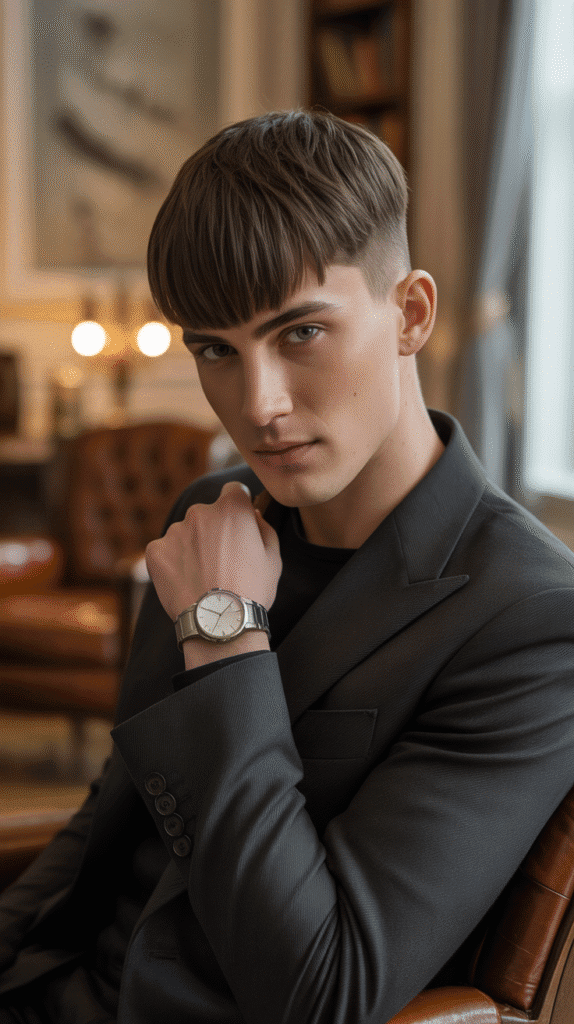
The Angular Fringe features a dramatically angled line of bangs that slopes diagonally across the forehead, creating geometric interest and artistic edge.
This avant-garde French style appeals to creative individuals seeking distinctive looks.
- The fringe is cut at a pronounced diagonal angle, typically shorter on one side and longer on the other.
- The angle can be subtle or dramatic depending on personal preference and lifestyle considerations.
- Back and sides are usually kept shorter to emphasize the angular fringe as the style’s focal point.
- Precise blow-drying and straightening may be necessary to maintain the sharp, geometric line.
- Medium-hold product keeps the angled fringe in place throughout the day without causing stiffness.
- This style requires skilled cutting and regular maintenance every 4-5 weeks to preserve the precise angle.
- The angular fringe works best on straight hair and suits men with oval or oblong face shapes.
21. Vintage Pompadour
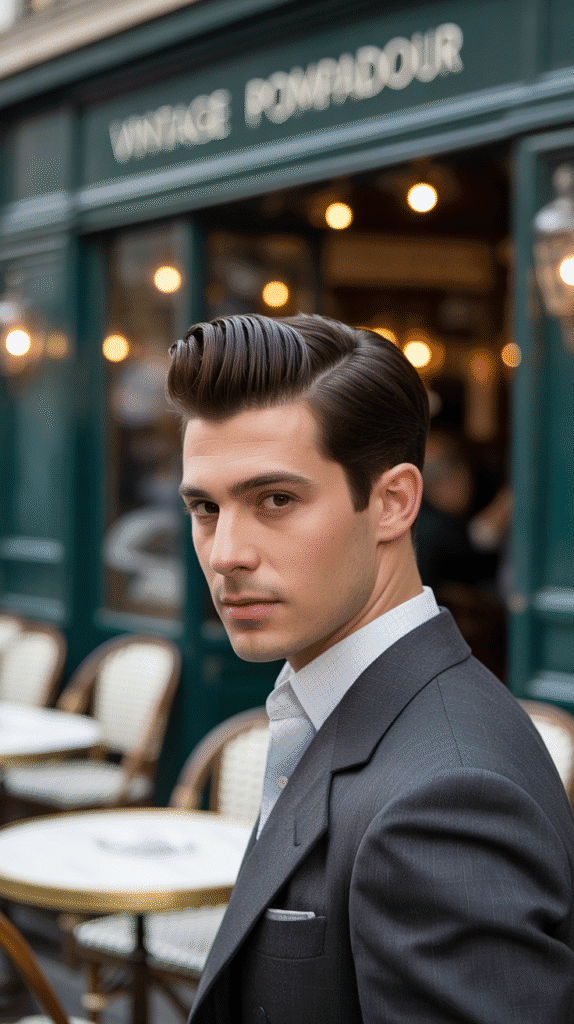
The Vintage Pompadour pays homage to 1950s rock and roll elegance with French sophistication, featuring dramatic height and volume at the front with smooth sides.
This classic style has experienced numerous revivals throughout French fashion history.
- The front section is styled to create impressive vertical height, often standing 3-4 inches tall or more.
- Hair is rolled backward from the forehead, creating a wave-like shape that defines the pompadour structure.
- Sides are either slicked back or trimmed shorter to avoid competing with the dramatic top section.
- Strong-hold pomade with high shine creates the authentic vintage appearance and maintains height throughout the day.
- This style requires significant length on top—minimum 5-6 inches for proper pompadour formation.
- Blow-drying with a round brush establishes the foundational shape before pomade application.
- The vintage pompadour makes a bold statement and suits men who appreciate retro aesthetics and classic style.
22. Short Textured Layers
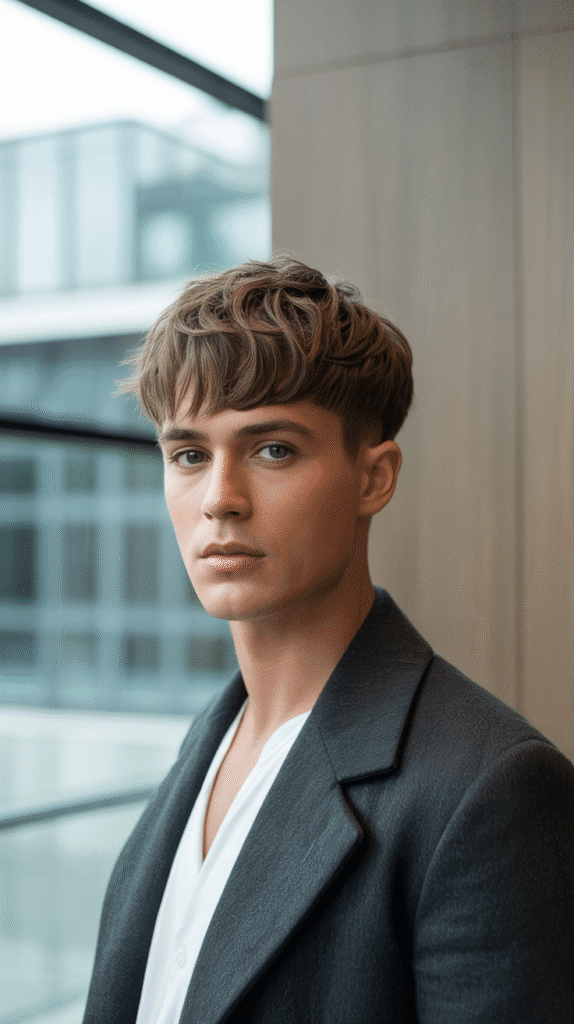
The Short Textured Layers style features multiple cutting lengths throughout the hair, creating dimensional movement and visual interest while maintaining short overall length.
This contemporary French cut offers sophistication through subtle complexity.
- Hair is cut to varying lengths between 1-3 inches, with shorter layers on sides and longer pieces on top.
- The layering creates natural texture and prevents the style from appearing flat or uniform.
- Styling involves working a small amount of texturizing product through damp hair with fingers.
- The piece-y, separated look is achieved by pulling small sections in different directions while product is damp.
- This cut works across multiple hair textures, though it shows most effectively on straight to wavy hair.
- The layered approach also helps manage thick, heavy hair by removing excess weight and bulk.
- Maintenance every 4-6 weeks preserves the layered structure and prevents the style from growing out shapeless.
23. Shaggy Mid-Length
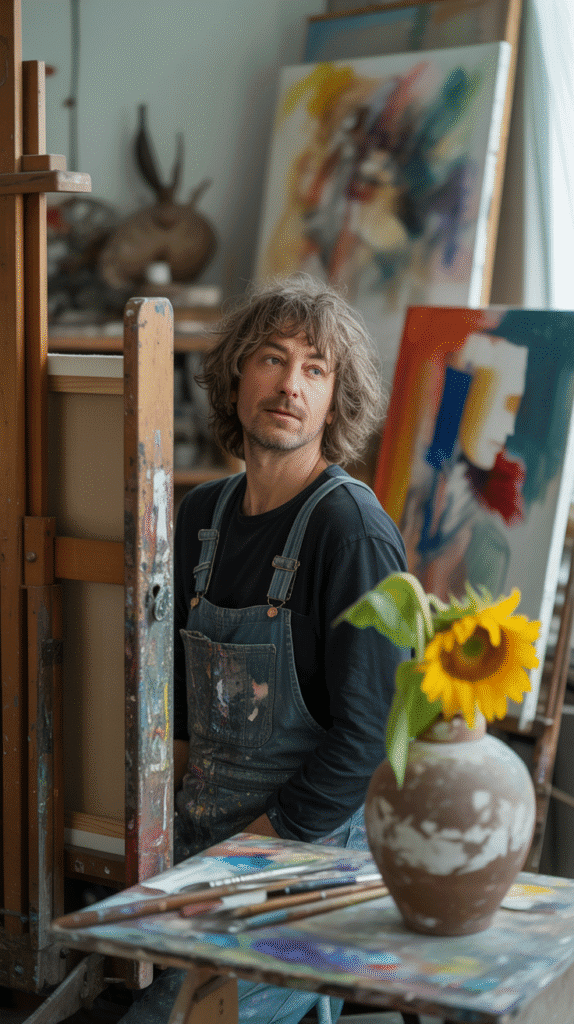
The Shaggy Mid-Length style embraces deliberate dishevelment with hair falling between the ears and collar in casually arranged layers.
This bohemian French look has been favored by artists, musicians, and creative professionals for generations.
- Hair grows to medium length, typically touching or slightly covering the ears and reaching the shirt collar.
- Multiple layers throughout create movement and prevent the style from appearing too heavy or structured.
- The “shaggy” quality comes from intentionally irregular cutting and minimal styling intervention.
- A small amount of sea salt spray or texturizing cream enhances natural wave and creates lived-in appearance.
- This style particularly suits men with natural wave or slight curl that provides inherent texture and body.
- Air drying is preferred to maintain the casual, unforced aesthetic central to this look.
- The shaggy mid-length requires less frequent trimming, with 6-8 week intervals adequate for maintenance.
24. Clean Taper

The Clean Taper provides a polished, professional foundation through gradually decreasing hair length from top to bottom without the dramatic contrast of fades.
This conservative French style offers versatility and timeless appeal.
- The taper creates smooth transition from longer hair on top (typically 2-4 inches) to progressively shorter hair down the sides and back.
- Unlike fades that reach skin level, tapers maintain visible hair coverage throughout, appearing more subtle and conservative.
- The gradual transition is achieved through precise clipper work with multiple guard lengths and scissor blending.
- Top hair can be styled in various ways—parted, textured, or slicked—while the tapered sides provide clean framing.
- This cut works in all professional environments and ages gracefully, suitable for men across all life stages.
- Maintenance every 4-5 weeks keeps the taper smooth and prevents awkward growth phases.
- The clean taper suits all face shapes and hair textures, making it one of the most universally flattering styles.
25. Loose Waves

The Loose Waves style celebrates natural wave patterns with strategic cutting and minimal styling that allows waves to form organic, flowing shapes.
This romantic French look captures Mediterranean coastal elegance.
- Hair is cut to medium length with layers that enhance and support natural wave patterns.
- The cutting technique removes excess weight that might pull waves straight while maintaining enough length for waves to form.
- Minimal product application—typically just a light curl-enhancing cream or wave spray on damp hair.
- Air drying or diffusing on low heat preserves the soft, natural wave formation without creating frizz or crunch.
- This style works exclusively for men with naturally wavy or loosely curly hair textures.
- Regular deep conditioning treatments maintain wave definition and prevent the dry, frizzy appearance.
- Loose waves complement relaxed, casual wardrobes and suit men comfortable with a less structured aesthetic.
26. Military Inspired Crew Cut
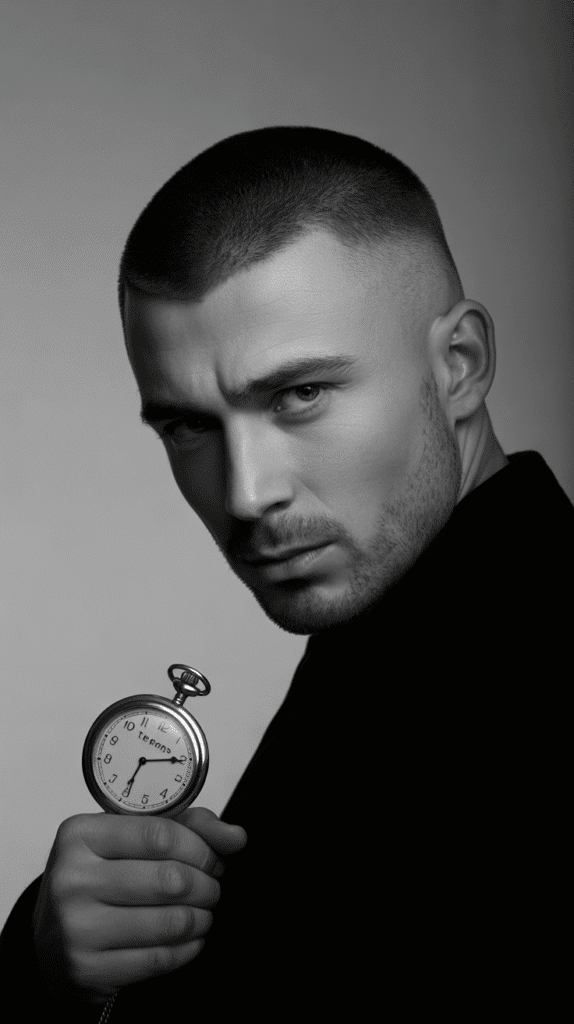
The Military Inspired Crew Cut combines practical short length with subtle French styling refinement, creating a no-nonsense look that remains polished and intentional.
This utilitarian style has maintained popularity through its combination of convenience and sophistication.
- Hair is clipped very short, typically using a #3 or #4 guard on sides and back.
- The top section is left slightly longer—approximately half an inch to one inch—creating subtle graduation.
- The front hairline receives particular attention, with hair cut to stand upright in a short, uniform manner.
- Minimal to no product is required, though a light matte paste can add slight definition for formal occasions.
- This cut emphasizes facial features and head shape, working best for men with well-proportioned faces and strong jawlines.
- Maintenance is frequent—every 2-3 weeks—to prevent the cut from growing out and losing its crisp appearance.
- The crew cut offers unmatched practicality while maintaining a groomed, intentional aesthetic.
27. Side Fade with Volume
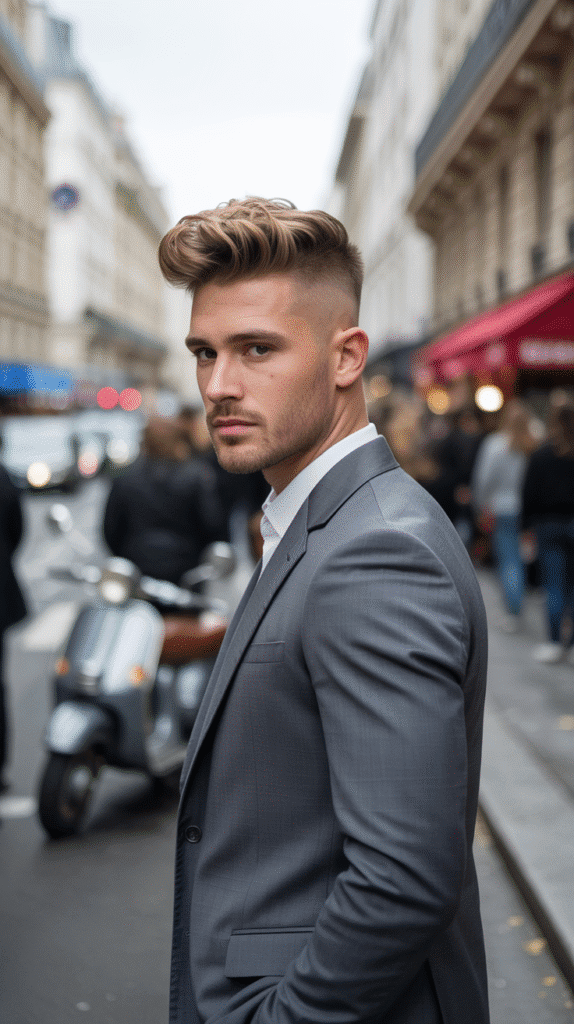
The Side Fade with Volume combines modern fade techniques with voluminous top styling, creating a contemporary French look that balances edgy sides with softer, fuller top section.
This hybrid style has become increasingly popular in urban French communities.
- A fade begins at the temples and progresses downward, transitioning from longer hair to very short or skin.
- The top section maintains substantial length—typically 3-5 inches—to create meaningful height and volume.
- Volumizing products like mousse or sea salt spray are applied to damp hair before blow-drying upward and back.
- The contrast between the clean, minimal sides and fuller top creates dynamic visual interest.
- This style suits men seeking modern edge while maintaining enough versatility for various settings.
- The fade requires frequent maintenance every 2-3 weeks, while the top can be trimmed less often.
- Side fades with volume work best on men with thick hair capable of holding volume and oval to square face shapes.
28. Refined Combover
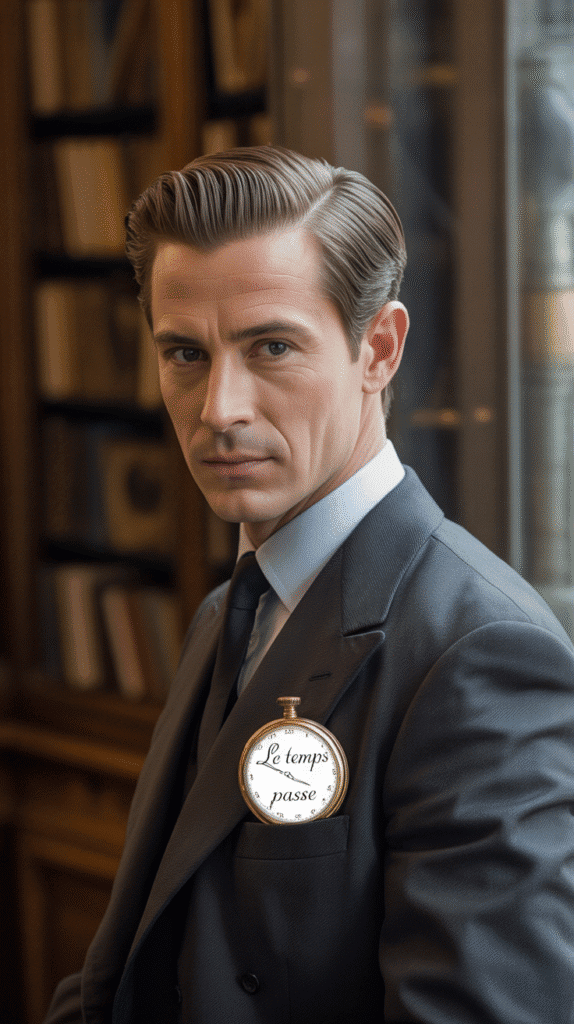
The Refined Combover reimagines the traditional combover as a sophisticated style choice rather than concealment technique, featuring precisely directed hair creating clean diagonal lines.
This elegant French approach elevates a historically misunderstood style.
- Hair is parted to one side, with the larger section combed across the head in a smooth, controlled manner.
- Unlike traditional combovers aimed at covering bald spots, the refined version is a deliberate style choice on full hair.
- Medium-hold pomade with moderate shine creates the smooth, polished finish while maintaining natural movement.
- The combover angle can be subtle or more pronounced depending on personal preference and face shape.
- This style works across various lengths but shows most effectively with 3-5 inches on top.
- Regular combing throughout the day may be necessary to maintain the precise direction and smooth surface.
- The refined combover suits mature men seeking sophisticated, classic elegance with contemporary execution.
29. Artistic Asymmetry
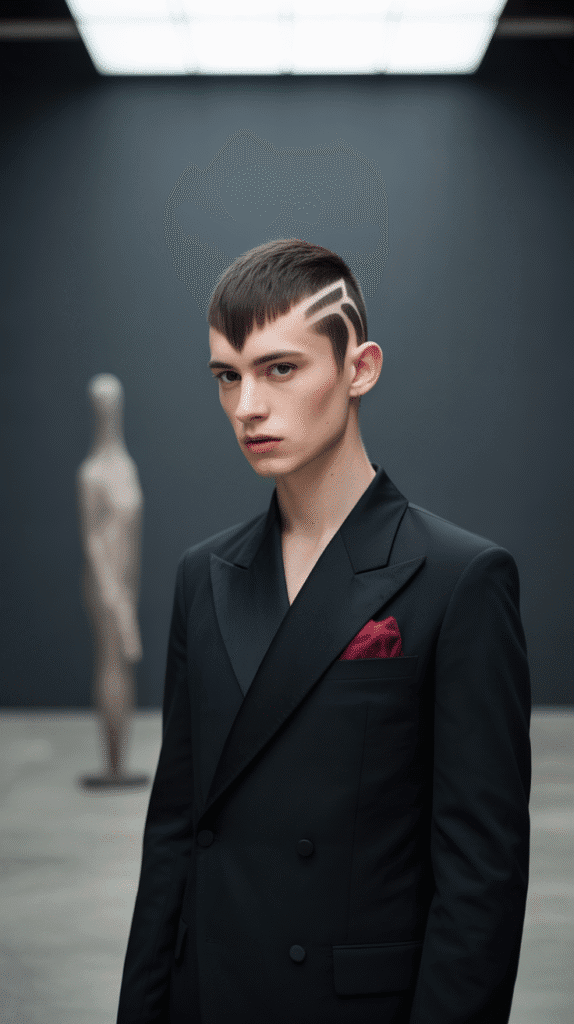
The Artistic Asymmetry style intentionally creates uneven lengths and directional patterns, resulting in a deliberately unbalanced look that makes a creative statement.
This avant-garde French cut appeals to artistic individuals and fashion-forward thinkers.
- Different sections of hair are cut to varying lengths without creating traditional symmetry.
- One side might be significantly longer than the other, or the front could differ dramatically from the back.
- The asymmetry is intentional and carefully planned rather than random or accidental.
- Styling emphasizes the uneven qualities through directional product application and strategic placement.
- This bold style requires confidence and works best for creative professionals in artistic fields.
- The cut demands skilled execution from experienced stylists familiar with asymmetrical techniques.
- Maintenance schedules vary based on the specific asymmetrical design but typically require 4-6 week intervals.
30. Classic Gentleman’s Cut
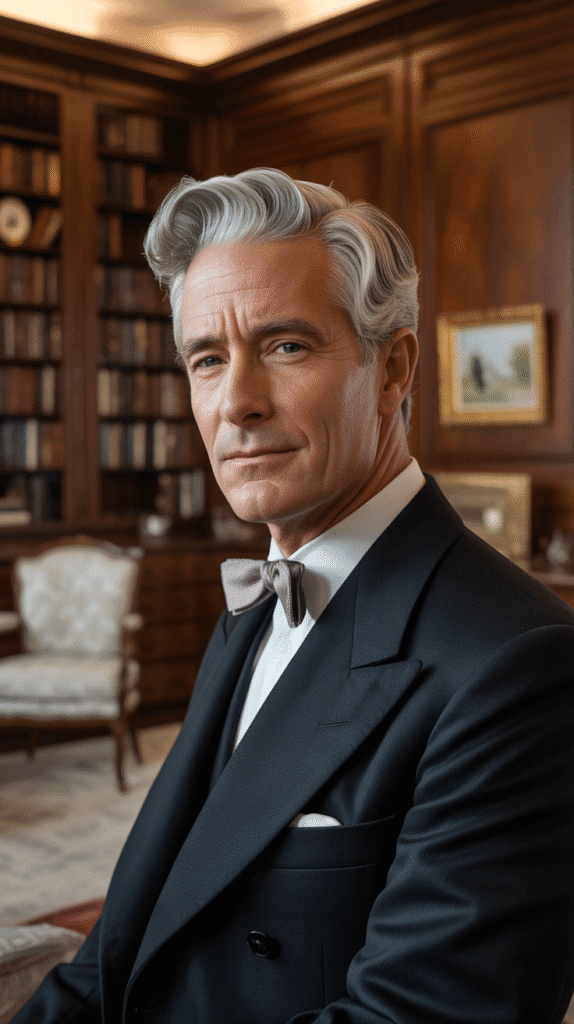
The Classic Gentleman’s Cut represents the pinnacle of timeless French masculine elegance, combining short to medium length with impeccable grooming and understated sophistication.
This definitive style transcends trends and remains perpetually appropriate.
- Hair is cut to a moderate length—typically 2-4 inches on top with shorter, tapered sides and back.
- A subtle side part or gentle backward sweep provides direction without appearing overly styled or rigid.
- The
Continue
finish is polished yet natural, achieved through light to medium-hold pomade with subtle shine.
- Every aspect of the cut emphasizes proportion, balance, and harmony rather than dramatic statements or trendy elements.
- This versatile style transitions seamlessly across all life situations, from business meetings to formal events to casual gatherings.
- Regular maintenance every 4-5 weeks preserves the refined proportions and immaculate appearance essential to this classic look.
- The gentleman’s cut suits all ages and face shapes, representing the ultimate expression of French masculine grooming philosophy.
Essential Styling Products for French Hairstyles
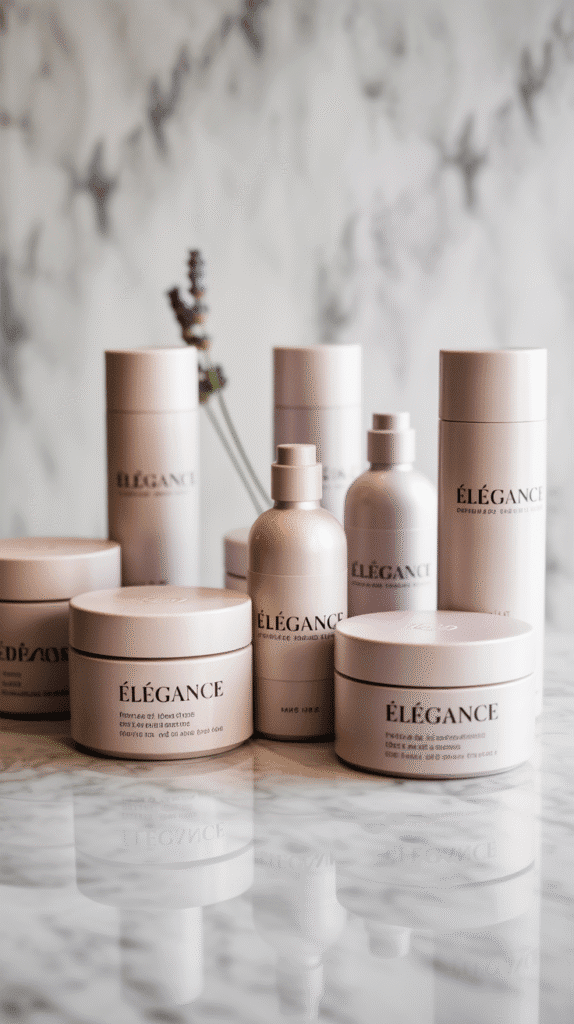
French hairstyling relies on a carefully curated selection of quality products that provide hold and finish without appearing heavy-handed or artificial.
Understanding which products work best for specific styles ensures authentic results.
- Matte Clay or Paste: Ideal for textured styles like the French Crop, Textured Quiff, and Short Textured Layers, providing strong hold with no shine.
- High-Shine Pomade: Essential for slicked-back styles and vintage looks, offering glossy finish and firm hold throughout the day.
- Medium-Hold Cream: The most versatile French styling product, working across multiple styles while maintaining natural movement.
- Sea Salt Spray: Perfect for enhancing natural texture in wavy and curly styles, creating that effortless beach-inspired appearance.
- Texturizing Powder: Adds volume and grip at the roots, particularly useful for styles requiring lift and dimension.
- Leave-In Conditioner: Maintains hair health in longer styles while providing subtle control without stiffness.
- Quality over quantity remains the French philosophy—investing in superior products yields better results than accumulating numerous mediocre options.
Hair Care Tips for Maintaining French Style
Achieving authentic French hairstyles extends beyond the cut and styling to encompass overall hair health and maintenance practices. French grooming emphasizes natural vitality and luster.
- Wash hair 2-3 times per week maximum to preserve natural oils that provide shine and manageability, avoiding the stripped appearance from over-washing.
- Use lukewarm or cool water for final rinse to seal hair cuticles and enhance natural shine, a technique favored in French salons.
- Apply conditioner only to mid-lengths and ends rather than roots to avoid weighing down hair and creating greasy appearance.
- Regular trims maintain shape and remove split ends before they travel up the hair shaft and compromise overall appearance.
- Protect hair from excessive heat styling by using heat protectant products and allowing air-drying whenever possible.
- Brush or comb gently from ends upward to minimize breakage and preserve hair integrity, particularly important for longer French styles.
- Consider seasonal adjustments to routine, as hair behaves differently in various weather conditions and may require modified product selection.
Choosing the Right French Style for Your Face Shape
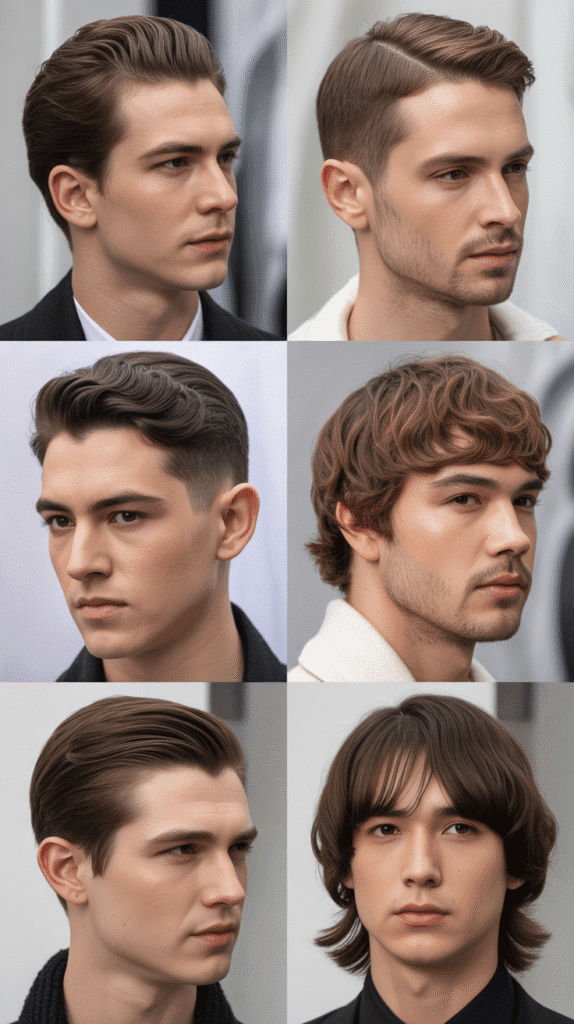
Selecting the most flattering French hairstyle involves understanding how different cuts interact with facial proportions and features.
French stylists prioritize harmony between hair and face structure.
- Oval Face Shape: The most versatile shape suits virtually all French styles, from slicked back undercuts to natural flow, providing freedom to choose based on personal preference.
- Square Face Shape: Styles with height and texture like the Textured Quiff or Pompadour Fade soften angular jawlines and balance strong facial features.
- Round Face Shape: Cuts creating vertical lines and height, such as the Vintage Pompadour or Side Fade with Volume, elongate the face and add definition.
- Heart Face Shape: Styles with volume at the sides like Medium Length Side Swept or Shaggy Mid-Length balance wider foreheads and narrower chins.
- Diamond Face Shape: Cuts with fullness like the Messy Fringe or Tousled Medium Length complement prominent cheekbones and soften angular features.
- Oblong Face Shape: Shorter styles with horizontal emphasis such as the French Crop or Caesar Cut add width and prevent excessive facial elongation.
- Consulting with an experienced French barber or stylist provides personalized guidance for selecting the most complementary style.
The Cultural Significance of French Male Grooming
French hairstyles carry deeper cultural meaning beyond mere aesthetic choices, reflecting values of self-respect, attention to detail, and the cultivation of personal style.
Understanding this context enriches appreciation for these timeless looks.
- French grooming philosophy emphasizes looking polished without appearing to labor over appearance, creating the impression of natural elegance.
- The concept of “bien dans sa peau” (comfortable in one’s skin) underlies French style, where grooming reflects inner confidence rather than external validation.
- Historical influences from French cinema, art movements, and literary figures have shaped masculine grooming ideals across generations.
- French barbershops traditionally serve as social spaces where men discuss culture, politics, and life while receiving expert grooming services.
- The French approach rejects extreme trends in favor of refined classics that age gracefully and remain appropriate across decades.
- Regional variations exist within France, with Parisian styles often appearing more structured while Mediterranean coastal areas embrace relaxed, natural approaches.
- Contemporary French grooming balances respect for tradition with selective adoption of modern techniques, creating evolving yet recognizable aesthetic standards.
Common Mistakes to Avoid
Even with quality haircuts and products, certain styling errors can undermine the sophisticated appearance characteristic of French hairstyles.
Awareness of these pitfalls helps maintain authentic results.
- Over-styling with excessive product creates stiff, unnatural appearance contrary to French aesthetic ideals of effortless elegance.
- Neglecting regular trims allows haircuts to grow out of shape, losing the precise proportions essential to many French styles.
- Choosing styles incompatible with natural hair texture results in daily frustration and inability to achieve desired appearance without excessive effort.
- Ignoring hair health in pursuit of style leads to damaged, dull hair that undermines even the best cuts.
- Following trends blindly rather than selecting styles complementing individual features contradicts French principles of personal style.
- Inconsistent maintenance schedules cause styles to appear neglected rather than casually elegant, missing the mark on French sophistication.
- Using low-quality products produces inferior results and may damage hair, making quality product investment worthwhile for authentic French styling.
Adapting French Styles for Different Settings
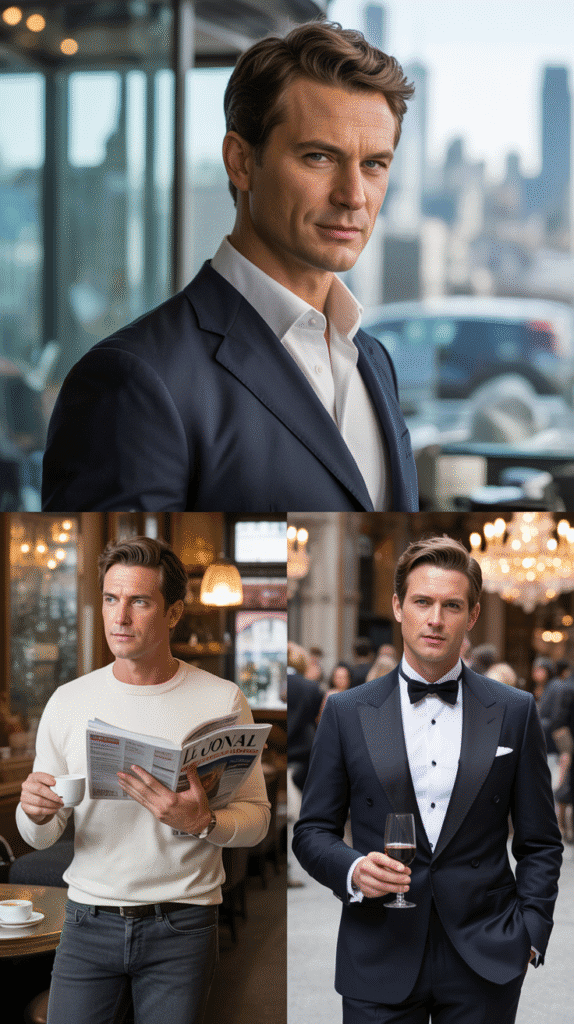
The versatility of French hairstyles allows strategic adaptation for various environments while maintaining core aesthetic principles.
Understanding these adjustments maximizes style utility.
- Corporate Professional Settings: Clean tapers, refined combovers, and Ivy League cuts project competence while remaining appropriately conservative.
- Creative Professional Environments: Textured styles, longer lengths like the Shaggy Mid-Length, and artistic asymmetry express individuality within professional context.
- Formal Evening Events: Slicked-back styles, vintage pompadours, and high-shine finishes create dramatic elegance suitable for special occasions.
- Casual Weekend Activities: Natural flow, messy fringes, and loose waves embrace relaxed styling appropriate for informal settings.
- Athletic or Active Pursuits: Shorter cuts like buzz cuts, crew cuts, and French crops provide practicality without sacrificing style.
- The same base cut can often be styled differently for various occasions by adjusting product type, application amount, and styling direction.
- French grooming philosophy encourages owning style choices across all settings rather than drastically changing appearance for different contexts.
Seasonal Considerations for French Hairstyles
Climate and seasonal changes affect hair behavior and styling requirements, necessitating strategic adjustments to maintain French hairstyles year-round.
Experienced French stylists account for these environmental factors.
- Summer Heat and Humidity: Lighter products with less hold accommodate increased moisture in the air, while shorter styles reduce heat discomfort.
- Winter Dryness and Static: Heavier conditioners and oil-based products combat dryness, while hats require styles that recover shape easily after compression.
- Spring Transition: Medium-hold products balance changeable weather conditions, while regular trims prepare for warmer months ahead.
- Autumn Preparation: Intensified conditioning treatments repair summer sun damage, while slightly longer lengths accommodate approaching cold weather.
- Seasonal product rotation ensures optimal performance as environmental conditions change throughout the year.
- Hair may behave differently in various seasons even with identical styling techniques, requiring flexible approach and product adjustment.
- French coastal regions particularly emphasize adapting styles for salt air exposure and Mediterranean sun intensity during summer months.
Conclusion
The enduring appeal of 30 Classic French Hairstyles for Men That Never Go Out of Style lies in their perfect balance between sophistication and wearability, proving that true elegance transcends fleeting trends.
These timeless cuts offer something for every man, regardless of hair type, face shape, or personal aesthetic preferences.
From the clean simplicity of the French Crop to the romantic appeal of Loose Waves, each style carries the distinctive French philosophy of looking polished without appearing overly styled.
The beauty of French grooming is its emphasis on enhancing natural features rather than fighting against them, creating looks that feel authentic and sustainable rather than forced or temporary.
Whether you prefer the bold statement of a Disconnected Undercut or the refined subtlety of a Classic Gentleman’s Cut, these hairstyles provide a foundation for developing personal style that ages gracefully.
By understanding proper maintenance, selecting appropriate products, and choosing cuts that complement your individual features, you can achieve that coveted French aesthetic that communicates confidence, sophistication, and timeless masculinity.
These thirty classic French hairstyles prove that investing in quality grooming is never wasted, as genuine style—like the finest French traditions—truly never goes out of fashion.